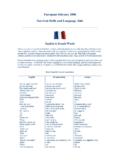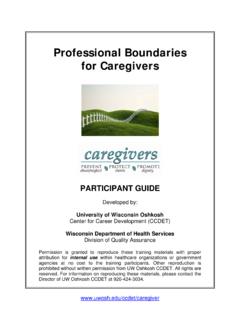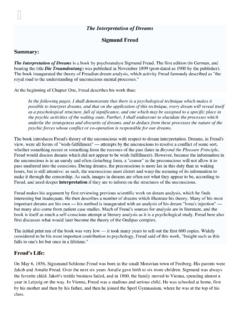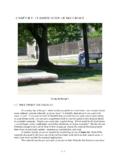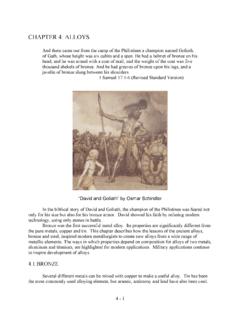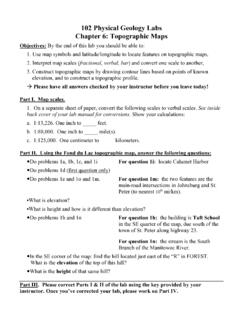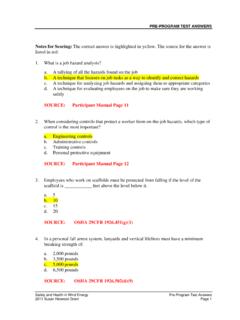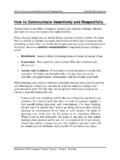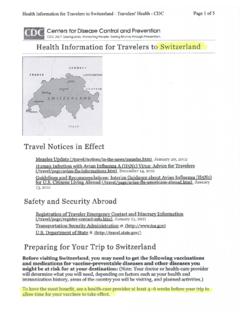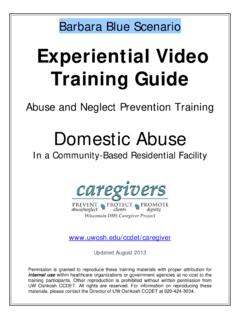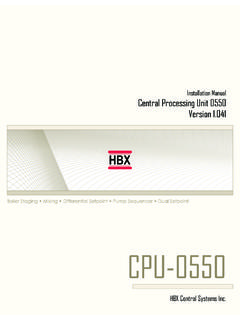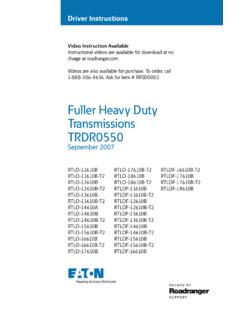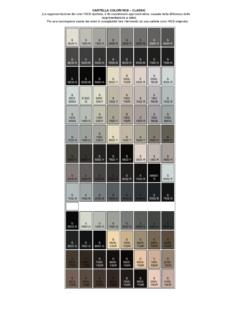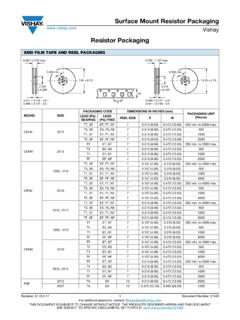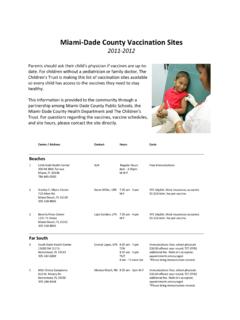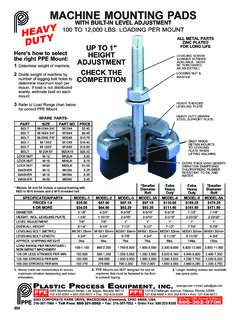Transcription of Health Education (0550) - University of Wisconsin Oshkosh
1 Copyright 2005 by Educational Testing Service. All rights reserved. EDUCATIONAL TESTING SERVICE, ETS, and the ETS logo are registered trademarks of Educational Testing PRAXIS SERIES is a trademark of Educational Testing at a Glance Test Name Health Education Test Code 0550 Time 2 hours Number of Questions 120 Format Multiple-choice questions Approximate Approximate Content Categories Number of Percentage of Questions Examination I. Health Education as a Discipline 18 15% II. Promoting Healthy Lifestyles 36 30% III. Community Health Advocacy 12 10% IV. Healthy Relationships 24 20% V.
2 Disease Prevention 18 15% VI. Health Education Pedagogy 12 10%About This TestThe Health Education test is designed to measure the professional knowledge of prospective teachers of Health Education in elementary schools, junior high schools, and senior high schools. The questions invite examinees to recall basic knowledge and to apply Education and Health principles to real-life situations. The content is appropriate for examinees who have completed a bachelor s degree program in Health Education . The 120 multiple-choice questions cover Health Education as a discipline, promoting healthy lifestyles, community Health advocacy, healthy relationships, disease prevention, and Health Education Education (0550)Copyright 2005 by Educational Testing Service.
3 All rights reserved. EDUCATIONAL TESTING SERVICE, ETS, and the ETS logo are registered trademarks of Educational Testing PRAXIS SERIES is a trademark of Educational Testing CoveredRepresentative description of topics covered in each category are providedbelow. I. Health Education as a Discipline Health literacy: critical thinking and problem solving, communication, responsible citizenship, and self-directed learning Responsibilities and competencies for entry-level Health educators National Health Education standards Morbidity, mortality, and behavioral risk data leading causes of death (YRBSS, BRFSS, SHPPS) CDC adolescent risk behaviors: unintentional/intentional injuries, HIV, STI s, unintended pregnancy, tobacco use, alcohol and other drugs, dietary patterns, and sedentary lifestyles Major Health behavior theories Coordinated school Health .
4 Health Education , physical Education , Health services, nutrition services, Health promotion for staff, counseling, psychological, and social services, healthy school environment, and family/community involvement Health /wellness domains Science foundations related to Health Code of Ethics for the Health Education profession II. Promoting Healthy Lifestyles Individual responsibility for healthy lifestyles: goal setting and decision making Physical fi tness and Health -related fi tness: body composition, cardiorespiratory endurance (cardiovascular fi tness), fl exibility, muscular strength and endurance, and individualizing exercise programs Nutrition: basic food groups/dietary goals, nutrients, metabolism, calories and fad diets, and dietary patterns Stress management coping skills Reducing and preventing Health risks.
5 Unintentional/intentional injuries (personal safety, basic fi rst-aid techniques), HIV, STI s, unintended pregnancy, tobacco use, alcohol and other drugs (OTC drugs, prescription drugs, generic drugs, illegal substances, non-drug drugs ( , caffeine), causes for the use and abuse of substances, alternate coping skills, physical and psychological effects, treatment, dietary patterns, and sedentary lifestyles Anatomy and physiology (body systems) III. Community Health Advocacy Health and safety laws and regulations: disease reporting, confi dentiality, work/recreational safety, controlled substances, immunizations, tobacco use, disabilities Environmental Health issues Consumer Health issues (quackery, advertising, Health -care delivery systems, insurance, importance of regular checkups, personal responsibility for Health care, Health myths ) Access valid Health information, products, and services Health careers (types of occupational positions, career possibilities, educational requirements prior to training, formal training required [number of years, types of programs]) Health agencies (public/private, services provided, cost considerations, Health care delivery systems) Leadership Community serviceHealth Education (0550))
6 Copyright 2005 by Educational Testing Service. All rights reserved. EDUCATIONAL TESTING SERVICE, ETS, and the ETS logo are registered trademarks of Educational Testing PRAXIS SERIES is a trademark of Educational Testing IV. Healthy Relationships Decision-making skills Growth and development: life stages and death and dying Psychosocial development: family structure relationships, peer relationships, self-concept, self-esteem, and character Education Interpersonal communication: confl ict resolution, assertiveness, refusal skills, I messages, and active listening Dating, marriage/partnerships, and parenting readiness and responsibility Sexuality: reproductive choices, sexual expression, sexual diffi culties, and pregnancy and infertility Violence: abuse (physical, verbal, emotional, and sexual) and bullying and harassment Diverse populations meeting pluralistic society s needs for Health Education relative to differing socioeconomic, cultural, and ethnic backgrounds V.
7 Disease Prevention Health conditions: acute and chronic, communicable and noncommunicable, infectious and noninfectious, genetic, congenital, environment-related, and myths and misconceptions Mental and emotional Health : depression, suicide, addictive behaviors, eating disorders, classifi cation of mental illness, and defense mechanisms Treatment and counseling Hygiene VI. Health Education Pedagogy Assessing learning needs (individual and community) Planning instruction (performance-based objectives, curriculum, and programs) Implementing instruction (methods, strategies, and techniques) Evaluating student learning and teacher effectivenessHealth Education (0550)Copyright 2005 by Educational Testing Service. All rights reserved. EDUCATIONAL TESTING SERVICE, ETS, and the ETS logo are registered trademarks of Educational Testing PRAXIS SERIES is a trademark of Educational Testing Test QuestionsThe sample questions that follow illustrate the kinds of questions in the test.
8 They are not, however, representative of the entire scope of the test in either content or diffi culty. Answers with explanations follow the : Each of the questions or statements below is followed by four suggested answers or completions. Select the one that is best in each case. 1. Which of the following is the correct order for the four major steps in designing a Health Education lesson plan? I. Developing instructional objectives andevaluation measures that are congruent II. Identifying several teaching strategies thatencourage teacher modeling and student participationIII. Setting scope and sequence boundaries for the topicIV. Determining the general focus for the lesson plan(A) I, IV, III, II(B) II, I, III, IV(C) III, I, IV, II(D) IV, III, I, II 2.
9 Essential amino acids are best described as those amino acids that are(A) required for protein synthesis but cannot be made by the body(B) naturally occurring substances that function in fi ghting infection(C) important components of carbohydrates, fats, and proteins(D) high-energy nutrients that promote growth and development 3. Which of the following high-school students is most likely to lose weight safely? Daily Daily Intake Expenditure Student (Calories) (Calories)(A) Robert 3,000 3,000(B) Judy 3,000 2,000(C) Tim 2,000 2,800(D) Alice 1,000 4,000 4.
10 Which of the following techniques will most accurately determine whether the fat composition of an individual s body is excessive?(A) Scales and a height-weight chart(B) Skin-fold calipers(C) Measurements of the circumference of waist, hips, thighs, and arms(D) Underwater weighingHealth Education (0550)Copyright 2005 by Educational Testing Service. All rights reserved. EDUCATIONAL TESTING SERVICE, ETS, and the ETS logo are registered trademarks of Educational Testing PRAXIS SERIES is a trademark of Educational Testing 5. The presence of the ozone layer in the upper atmosphere is important because(A) it enhances the greenhouse effect(B) it has led to sharp increases in all types of skin cancer(C) it absorbs harmful ultraviolet radiation(D) it reduces the amount of acid rain and urban smog 6.
